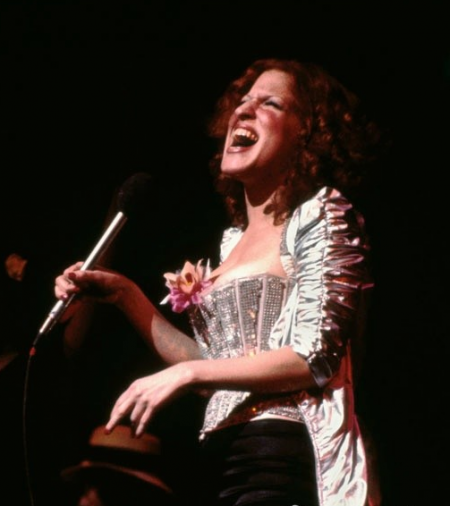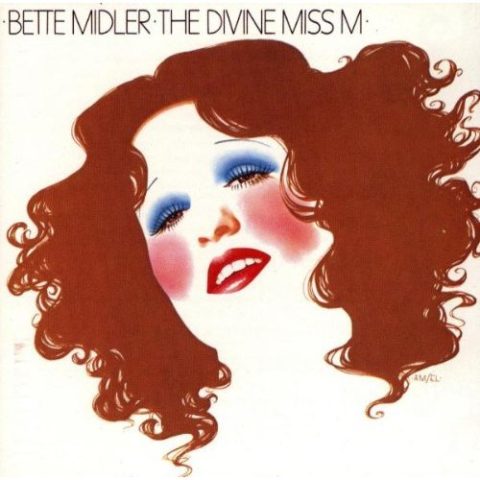European Stars And Stripes
March 27, 1973
THE Divine Miss M., as she calls herself, has been described as a funky blend of Mae West, Edith Piaf, Lotte Lenya and Sophie Tucker. On her first cabaret date in Hollywood, Calif., a sellout week at the Troubadour, she estabished a personality that shines with the grandes dames of the music halls.
Tagged by critics as “a bona fide original, an electric chanteuse,” the Divine Miss M. is also known as Bette Midler, and she insists it’s her real name. Bette is pronounced “Bet,” because, according to Miss Midler, her mother thought that was how a famous movie star pronounced her first name.
Until last year, Bette Midler was hardly known outside New York.
Her songs, sung in a smoky, somewhat plaintive voice, are a collection of ribald rock, pop, blues and oldies but goodies, all topped with some undulating hands-on hips vamp and a bit of camp. But what; puts her in the classic music-hall tradition is the way she involves an audience with herself.
Her costume depends upon her mood.
“If I’m feeling good, I may trash it up with a silver lame I found at the Salvation Army,” she quipped. At the Troubadour, she wore clunky shoes, slacks and an unbuttoned blouse, knotted carelessly at the waist.
Unlike some other gifted funny girls, Miss Midler allows her own personality to spill from the stage – outrageous, raunchy, troubled. Hers is not a calculated image. She’s real. Pausing to kibbitz between numbers, she confides to the packed house, in a voice of cheap perfume, “I’m the last of the tacky women. . . trash with flash.”
During her act, backed by a quartet of musicians, she sits only for “Am I blue?,” a torch song about the fragile nature of love. Mostly, she’s dancing and strutting across the stage, encouraging tumult by urging everyone to join her in “Sh-Boom,” a surprise audience request, that she transforms into an evangelical aria, with Miss Midler, who seems very New York, was raised In Hawaii where her father was a house painter. She stands a little over 5 feet In her ankle-straps. Her eyebrows are clipped parentheses, and she paints her face for the last days of the Weimar Republic.
Frizzy orange curls grow in her wild hair like snapdragons pleading for water. Her costume depends upon her mood. “If I’m feeling good, I may trash it up with a silver lame I found at the Salvation Army,” she quipped. At the Troubadour, she wore clunky shoes, slacks and an unbuttoned blouse, knotted carelessly at the waist.
She looked somewhat different as T/.eitel, the drab oldest daughter in “Fiddler on the Roof,” her first New York job, which kept her on Broadway for three years. “I began studying with the dancer in the show who taught me the art of collage, how to put an emotion into movement,” she explained.
“I learned how much emotion a singer can project. We’d get high together listening to recordings of the great divas.”
She was also in the Off Broadway musical, “Salvation,” which didn’t last long.
Then, to keep active and from starving she began singing in clubs. “Most of them were dumps,” she admitted with a disarming smile, “but it’s how I started this . . . thing of mine. Agents weren’t interested. My career took off when I sang at the Continental Baths in New York. Those tubs became the showplace of the nation. I made ’em respectable. Lillian Roth, everybody, sings’there now.”
APPEARANCES on television with Johnny Carson and David Frost enlarged her audience and broadened her style. “I love performing anywhere; I thrive on the madness,” she said. “Even though it’s hysterical, I’d like to be taken seriously. I’d like to be considered an artist.”
Assuming the position of a corseted opera star, she clowned: “I have a few more musical statements to make before I leave my public.”
On the surface, Miss Midler, who jokes that she’s “younger than springtime or as old as you want me to be,” is all hubbahubba put-on. Her wit simply masks the vulnerability. “Growing up in Hawaii,” she remembered wistfully, “I had fancies about the South Seas. There was no romance, no moon of Manakoora where we lived. It was the ghetto. Can you imagine being the only poor, white, Jewish family in a neighborhood of Eurasians?”












